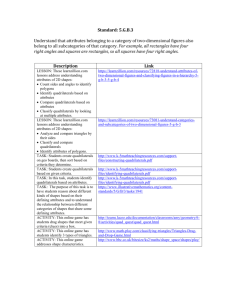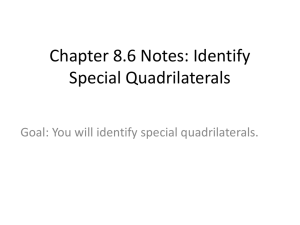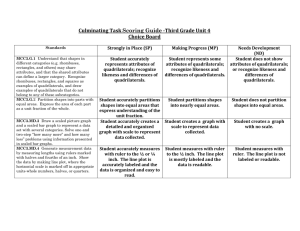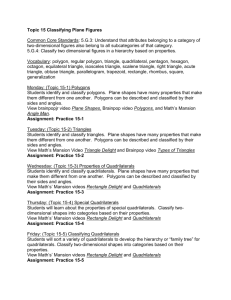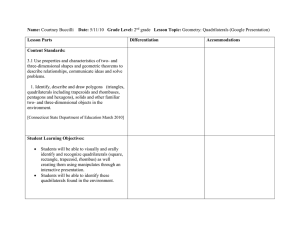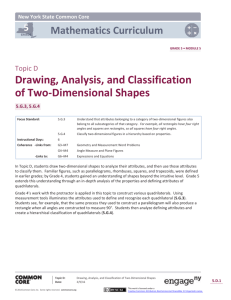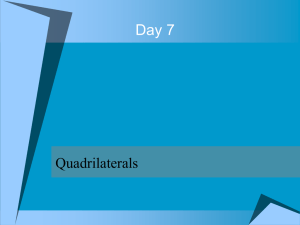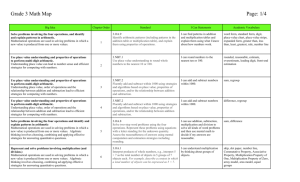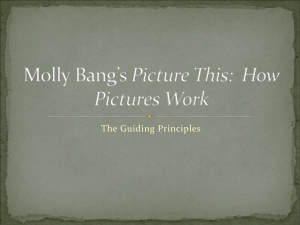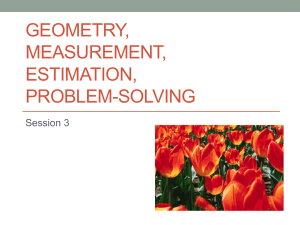Topic 11-Geometry
advertisement
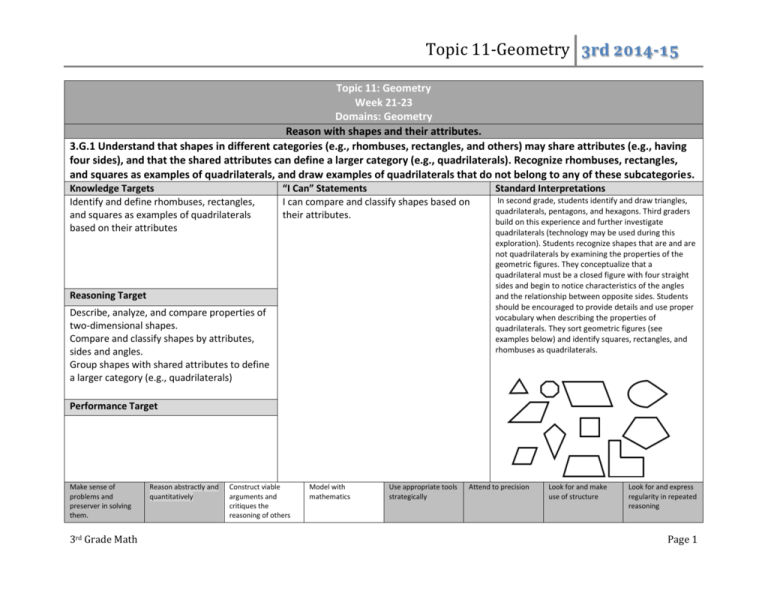
Topic 11-Geometry 3rd 2014-15 Topic 11: Geometry Week 21-23 Domains: Geometry Reason with shapes and their attributes. 3.G.1 Understand that shapes in different categories (e.g., rhombuses, rectangles, and others) may share attributes (e.g., having four sides), and that the shared attributes can define a larger category (e.g., quadrilaterals). Recognize rhombuses, rectangles, and squares as examples of quadrilaterals, and draw examples of quadrilaterals that do not belong to any of these subcategories. Knowledge Targets Identify and define rhombuses, rectangles, and squares as examples of quadrilaterals based on their attributes “I Can” Statements I can compare and classify shapes based on their attributes. Reasoning Target Describe, analyze, and compare properties of two-dimensional shapes. Compare and classify shapes by attributes, sides and angles. Group shapes with shared attributes to define a larger category (e.g., quadrilaterals) Standard Interpretations In second grade, students identify and draw triangles, quadrilaterals, pentagons, and hexagons. Third graders build on this experience and further investigate quadrilaterals (technology may be used during this exploration). Students recognize shapes that are and are not quadrilaterals by examining the properties of the geometric figures. They conceptualize that a quadrilateral must be a closed figure with four straight sides and begin to notice characteristics of the angles and the relationship between opposite sides. Students should be encouraged to provide details and use proper vocabulary when describing the properties of quadrilaterals. They sort geometric figures (see examples below) and identify squares, rectangles, and rhombuses as quadrilaterals. Performance Target Make sense of problems and preserver in solving them. 3rd Grade Math Reason abstractly and quantitatively Construct viable arguments and critiques the reasoning of others Model with mathematics Use appropriate tools strategically Attend to precision Look for and make use of structure Look for and express regularity in repeated reasoning Page 1 Topic 11-Geometry 3rd 2014-15 Reason with shapes and their attributes. 3.G.2 Partition shapes into parts with equal areas. Express the area of each part as a unit fraction of the whole. For example, partition a shape into 4 parts with equal area, and describe the area of each part as ¼ of the area of the shape. Knowledge Targets Know that shapes can be partitioned into equal areas. Describe the area of each part as a fractional part of the whole. “I Can” Statements I can divide a shaped into equal fractional parts. Standard Interpretations Given a shape, students partition it into equal parts, recognizing that these parts all have the same area. They identify the fractional name of each part and are able to partition a shape into parts with equal areas in several different ways. Reasoning Targets Relate fractions to geometry by expressing the area of part of a shape as a unit fraction of the whole. Make sense of problems and preserver in solving them. 3rd Grade Math Reason abstractly and quantitatively Construct viable arguments and critiques the reasoning of others Model with mathematics Use appropriate tools strategically Attend to precision Look for and make use of structure Look for and express regularity in repeated reasoning Page 2 Topic 11-Geometry 3rd 2014-15 Topic 11: Two-Dimensional Shapes & Their Attributes Points Equilateral Triangle Line Isosceles Triangle Line Segment Scalene Triangle Intersecting Lines Right Triangle Parallel Lines Acute Triangle Ray Obtuse Triangle Angle Trapezoid Vertex (vertices) Parallelogram Right Angle Rectangle Perpendicular Rhombus Acute Angle Square Obtuse Angle Polygon Side Diagonal Triangle Quadrilateral Pentagon Hexagon Octagon Decagon 3rd Grade Math Page 3 Topic 11-Geometry 3rd 2014-15 3rd Grade Math Page 4
